- There are no more items in your cart
- Shipping Calculated at checkout
-
Sub-Total (inc. VAT)
£0.00
Need Help?
Mould Resistant Paints
Mould resistant paints are specially formulated coatings designed to prevent the growth of mould, mildew, and fungi on painted surfaces. These paints are infused with biocides that inhibit the growth of microorganisms, making them ideal for areas with high humidity and poor ventilation. Mould resistant paints are particularly beneficial for bathrooms, kitchens, basements, and other moisture-prone areas. By applying these paints, you can protect your home or business from the unsightly appearance and health risks associated with mould and mildew. Click here for more info.
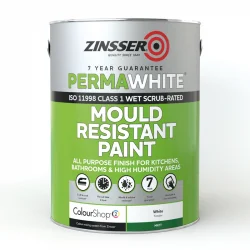
Zinsser Perma-White Interior
Available in 4,400+ matt and satin colours. Suitable for use on interior walls, ceilings, trim, doors, and more. Prevents mould and mildew growth on the paint film for up to 5 years. Self-priming with excellent adhesion to glossy and hard-to-paint surfaces. Durable, washable, moisture-resistant finish that resists dirt pickup. Low...
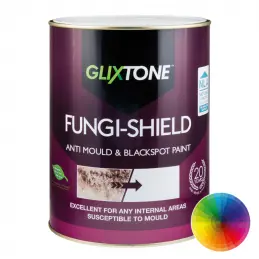
Glixtone Fungi-Shield Anti-Mould & Black Spot Paint
A washable, decorative and highly effective fungicidal anti-mould paint for internal walls and ceilings. Suitable for walls, ceilings, woodwork, bathrooms, shower rooms, kitchens, bedrooms, living areas. Ideal for use by Landlords who can face an on-going battle with properties and the infestation of mould which is both unsightly and a...
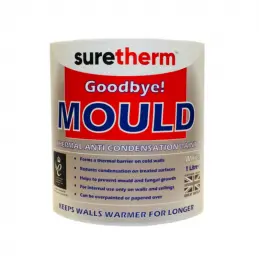
N-Virol Suretherm Goodbye Mould Thermal Anti Condensation Paint
Anti Condensation Paint ideal for use on cold walls and ceilings in your home or office which may be susceptible to condensation, mould and heat loss. Other uses include steel frame buildings, metal cladding, garage roofs, shipping containers and as part of an underfloor heating system. For internal use only on walls and ceilings - Helps...

Protection Paints Zero-Mould
A high performance water-based acrylic interior paint in 260 colours, uniquely formulated to beautify and protect interior surfaces while preventing mould and mildew growth on the paint film. Zero-Mould produces a tough, durable, washable finish that withstands moisture and resists dirt pickup. For use on interior walls, cavities, ceilings,...
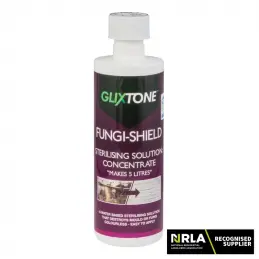
Glixtone Fungi-Shield Concentrated Sterilising Solution
Approved by the National Residential Landlords Association (NRLA), destroys mould or fungi, sterilising prepared surfaces prior to the application of Glixtone Fungi-Shield Paint. Ideal for any internal areas that are susceptible to mould or organic growth including: walls, ceilings, woodwork, bathrooms, shower rooms, kitchens, bedrooms and...

SmartSeal ClimaShield Anti-Mould Paint
10 colours in a matt finish. For interior surfaces such as bathrooms, bedrooms, basements and kitchens. Solvent free, low VOC. Suppresses and resists black mould growth. Samples available.
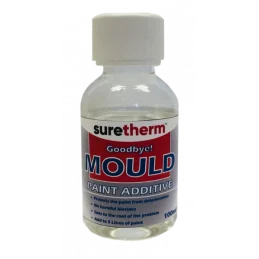
N-Virol Suretherm Goodbye Mould Paint Additive
Specially designed to be added to emulsion paint which can then be applied to walls and ceilings which have been suitably cleaned and prepared. This product will stop grime/stains from mould caused by condensation. Easy application - Add 100ml to 5 litres of standard emulsion paint and mix thoroughly until an even colour is achieved and...
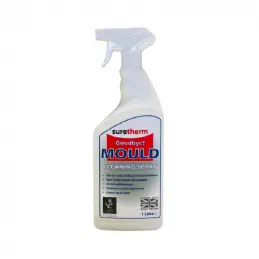
N-Virol Suretherm Goodbye Mould Cleaning Spray
Designed to remove surface grime and stains caused by condensation and black mould. It does not contain any harmful biocides and is formulated using natural ingredients. This product should be used prior to the application of N-Virol Suretherm Anti Condensation Paint. Cleans walls, ceilings and hard surfaces. Easy application. Gets to the...
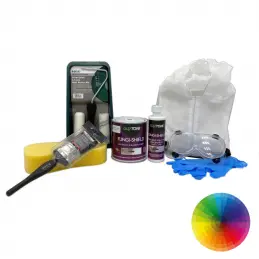
Glixtone Fungi-Shield Anti-Mould Paint Kits
Contains everything you need to provide a washable, decorative fungicidal, anti-mould, paint finish to areas susceptible to mould and bacterial growth. Suitable for walls, ceilings, woodwork, bathrooms, shower rooms, kitchens, bedrooms, living areas. Internal use only on any above ground surface to eliminate mould, algae and fungus....
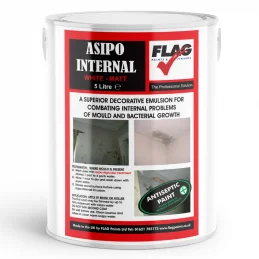
Flag Asipo Internal Anti-Mould
A superior water-based decorative anti-mould emulsion. Provides long-term protection from mould and algae and is designed to stop contamination and discolouration on masonry and plaster. Economic and easy to apply - long lasting durable finish for internal wall and ceilings Part of the Flag Asipo range of protective coatings Please...
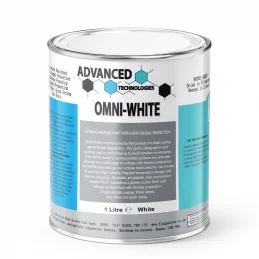
Flag Advanced Technologies Omni-White
A general purpose paint with added anti-fungal protection. For interior use on plaster, wood, concrete and painted surfaces Seals porous surfaces - ideal for use in areas of persistent high humidity, frequent temperature changes and poor air circulation Washable, scrubbable, stain and moisture resistant finish Self-priming fade...
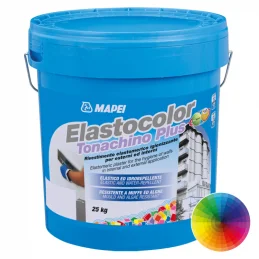
Mapei Elastocolor Tonachino Plus
An elastomeric plaster for the hygiene of walls, in internal and external applications. Fibre-reinforced, rustic effect coating for all new, old or painted surfaces, surfaces with hairline cracks, or surfaces in areas where particular local climatic conditions facilitate the growth of algae and mould. Application examples include:...

Owatrol VC175 Mould Killer
Stops mould growth - add to paint, mortar, grout or adhesives. Long-lasting - powerful mould and algae killer.
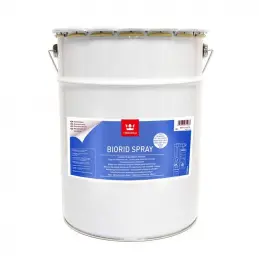
Tikkurila BioRid Spray
Waterborne functional coating containing micropores, which eliminate moisture and keep the surface dry. Especially suitable for new and previously painted surfaces in conditions where protection of the paint film from mold contamination is required. Suitable for interior coating of walls and ceilings. On substrates of concrete, plaster,...

Watco Moisture Guard
Watco Moisture Guard Product Description For new or previously painted drywall, plaster, cement, concrete, and more. For interior use where circulation is poor. Touch dry in 30 minutes, recoat after 2 hours. Protects against fungal degradation once dry. Applied via brush or roller.
Need Help?
Need Help?
Understanding Mould Growth
Mould growth is a common issue in areas with high moisture levels. Mould spores thrive in damp, warm environments, attaching to surfaces and proliferating rapidly. The presence of mould can lead to structural damage and health problems, including respiratory issues, allergies, and asthma.
Causes of Mould Growth
- Humidity: High humidity levels provide the perfect breeding ground for mould spores.
- Poor Ventilation: Insufficient airflow allows moisture to accumulate, promoting mould growth.
- Water Leaks: Leaking pipes, roofs, or windows can introduce excess moisture into an area.
- Condensation: Frequent condensation on surfaces like windows and walls can also lead to mould.
Areas Most Prone to Mould Growth
Mould tends to grow in areas where there is a consistent presence of moisture and lack of adequate ventilation:
- Bathrooms: Constant steam from showers and baths can lead to high humidity levels, causing mould to grow on walls, ceilings, and around tiles.
- Kitchens: Cooking activities generate steam, which can lead to mould growth on walls, ceilings, and cabinets.
- Basements: These areas often have poor ventilation and can be damp, making them prime locations for mould growth.
- Laundry Rooms: The moisture from washing machines and dryers can create an environment conducive to mould growth.
- Attics: Poor insulation and ventilation can lead to condensation and mould growth on the roof and walls.
Mould Resistant Paint: How It Works
Mould resistant paints are formulated with biocides and fungicides that inhibit the growth of mould and mildew. These paints form a protective film that prevents mould spores from adhering to and growing on the painted surface. In addition to their mould-resistant properties, these paints are also designed to be washable and durable, making them suitable for high-traffic and high-moisture areas.
Other Methods to Prevent Mould Growth
In addition to using mould resistant paints, several measures can help manage and reduce mould growth:
- Improving Ventilation: Installing extractor fans in bathrooms and kitchens, and ensuring good airflow throughout the property by opening windows and using vents.
- Using Dehumidifiers: Dehumidifiers help reduce the overall moisture content in the air, making it less likely for mould to grow.
- Fixing Leaks: Repairing any leaks in roofs, pipes, and windows to prevent moisture ingress.
- Regular Cleaning: Cleaning surfaces regularly with mould-killing products to remove any spores before they can grow.
Seasonal and Structural Considerations
In the UK, mould issues are more prevalent during the autumn and winter months due to increased indoor heating and higher levels of indoor humidity. Buildings with poor insulation and inadequate ventilation systems are particularly vulnerable. Structural elements like uninsulated walls and roofs can contribute to mould problems, making it essential to consider both seasonal changes and structural integrity when addressing mould issues.
Health Risks Associated with Mould
Mould exposure can lead to various health problems, including respiratory issues, allergies, and asthma. The World Health Organization (WHO) has highlighted that damp and mouldy environments can increase the risk of respiratory infections and exacerbate asthma and allergic conditions. The UK government also provides guidelines for maintaining healthy indoor environments to mitigate the health risks associated with mould.
Building Materials and Mould Resistance
Certain building materials are more prone to mould growth than others. Understanding which materials are susceptible can help in taking preventive measures:
- Wood: Wood is organic and can absorb moisture, making it a prime target for mould.
- Drywall: Drywall can become damp and provide a breeding ground for mould.
- Concrete and Brick: These materials can retain moisture if not properly sealed, leading to mould growth.
- Insulated Materials: Properly insulated materials can help maintain a dry environment and prevent mould growth.
Mould Resistant Paints in Various Sectors
Public Sector Buildings and Facilities
Public sector buildings such as schools, hospitals, and government offices often face mould issues due to high occupancy levels and varied usage patterns. In schools, mould can form in classrooms, gymnasiums, and locker rooms due to fluctuations in temperature and humidity. Hospitals need to maintain strict hygiene standards, and mould can compromise patient safety by fostering harmful bacteria.
Public Use Areas and Communal Buildings
Community centres, libraries, and leisure centres experience high foot traffic and usage, leading to significant moisture generation. Showers and changing rooms in leisure centres are particularly prone to mould, which can pose safety hazards and health risks.
Commercial Buildings and Establishments
Commercial establishments such as offices, retail stores, and restaurants often struggle with mould in areas like restrooms, kitchens, and storage rooms. Restaurants generate large amounts of steam from cooking, making them susceptible to mould growth. Retail stores with large display windows can also experience condensation and mould issues, affecting visibility and creating maintenance challenges.
Industrial Plants and Food Processing Plants
Industrial facilities, including food processing plants, manufacturing, and packaging plants, face significant mould challenges. Food processing plants require stringent hygiene standards, and mould can lead to contamination and spoilage. Manufacturing and packaging plants need effective mould management to maintain product quality and worker safety.
Agricultural Sector
In agricultural settings, mould can be a significant problem in greenhouses, storage facilities, and animal housing. Greenhouses need to maintain specific humidity levels for optimal plant growth, and mould can disrupt this balance. Storage facilities for grains and other produce must remain dry to prevent spoilage, and mould can compromise these conditions. Animal housing, where warmth and humidity levels are high, is also susceptible to mould, potentially affecting animal health.
Mould Resistant Paints for Windows, Window Sills, Ceilings, and Walls
Windows and Window Sills
Windows and window sills are common sites for mould growth due to condensation. Single-glazed windows are particularly prone to this problem. Mould resistant paints can be applied around windows and sills to prevent mould growth caused by condensation.
- Double-Glazing: Upgrading to double-glazed windows can significantly reduce condensation and mould.
- Regular Ventilation: Ensuring proper ventilation helps reduce indoor humidity levels.
- Dehumidifiers: Using dehumidifiers in rooms with high moisture levels can help control condensation and mould.
Ceilings and Walls
Mould on ceilings and walls is common in areas with poor ventilation and high humidity, such as bathrooms and kitchens. It can lead to unsightly stains, paint peeling, and health hazards.
- Improved Ventilation: Installing extractor fans in high-humidity areas helps remove moist air before it can condense and cause mould growth.
- Mould Resistant Paint: Applying mould resistant paint to ceilings and walls provides a protective barrier that prevents mould growth.
- Insulation: Adding insulation to walls and ceilings can help maintain a consistent surface temperature, reducing the likelihood of condensation and mould.
What Mould Issues Look Like
Identifying mould problems early can help prevent more serious issues from developing. Here are some common signs of mould:
- Black Spots: Visible black spots of mould on walls, ceilings, and around windows.
- Musty Smell: A musty odour indicates the presence of mould, even if it is not immediately visible.
- Damp Patches: Dark, damp patches on walls and ceilings can indicate mould growth.
- Peeling Paint and Wallpaper: Moisture can cause paint to blister, peel, and flake off, and can make wallpaper bubble and detach from the walls.
- Health Symptoms: Unexplained respiratory issues, allergies, and skin irritations in occupants can be signs of mould exposure.
Consequences of Ignoring Mould
Ignoring mould issues can lead to a range of problems, affecting both the structure of buildings and the health of their occupants:
- Structural Damage: Persistent mould can weaken the structural integrity of buildings by deteriorating materials such as wood and plaster.
- Health Issues: Mould exposure can cause respiratory problems, allergies, asthma, and other health issues.
- Damage to Interiors: Decorative finishes like paint, wallpaper, and plaster can suffer significant damage from ongoing mould growth.
- Increased Maintenance Costs: Regular cleaning and redecoration can become necessary if mould is not properly addressed.
- Property Value: Properties with noticeable mould issues can suffer a reduction in value.
Comprehensive Mould Management
Effective management of mould involves a multifaceted approach that includes the use of mould resistant paints and other preventive measures:
- Mould Resistant Paint: Applying mould resistant paint is a proactive measure to prevent mould from forming on walls and ceilings. These paints create a protective barrier that keeps surfaces dry and mould-free.
- Ventilation: Improving ventilation through the installation of extractor fans, opening windows, and using dehumidifiers helps reduce indoor humidity levels.
- Insulation: Proper insulation of walls, ceilings, and windows helps maintain a consistent temperature, reducing the risk of condensation and mould growth.
- Regular Maintenance: Regular inspection and maintenance of buildings, including checking for leaks, repairing damaged surfaces, and ensuring proper insulation, are crucial in preventing mould. Addressing small issues promptly can prevent more significant problems from developing.
- Professional Assessment: For severe cases, consulting with a professional can help identify the root cause of mould issues and recommend tailored solutions. Professionals can conduct thorough inspections and provide expert advice on the best measures to take.
By understanding the signs of mould and addressing them promptly with effective measures, property owners can protect their buildings from structural damage, maintain a healthy indoor environment, and avoid costly repairs. Mould resistant paints, combined with proper ventilation and insulation, offer a comprehensive solution to managing mould issues.
When to Call a Specialist
While many mould issues can be managed with DIY methods and regular maintenance, there are situations where professional intervention is necessary:
Signs You Need a Specialist
- Extensive Mould Growth: If the mould covers a large area (more than 10 square feet) or multiple rooms, it’s time to call a professional.
- Recurrent Mould Problems: If mould keeps returning despite your efforts to clean and repaint, there may be an underlying issue that needs professional assessment.
- Health Symptoms: If occupants are experiencing unexplained respiratory problems, allergies, or other health issues that seem related to mould exposure, it’s crucial to seek professional help.
- Structural Damage: If mould has caused visible structural damage to walls, ceilings, or floors, a specialist is needed to assess and repair the damage.
- Water Damage: Mould resulting from significant water damage (like flooding or major leaks) often requires professional remediation to ensure all affected areas are thoroughly dried and treated.
Benefits of Professional Help
- Thorough Inspection: Professionals can conduct a comprehensive inspection to identify the extent of mould growth and the underlying causes.
- Effective Remediation: Specialists have the tools and expertise to remove mould safely and effectively, preventing future growth.
- Health Protection: Professionals can ensure that mould remediation is done safely, protecting the health of building occupants.
- Long-Term Solutions: By addressing the root causes of mould, professionals can provide long-term solutions that prevent recurrence.
FAQs About Mould Resistant Paint
What is mould resistant paint?
Mould resistant paint is a specialised coating that contains biocides and fungicides to prevent the growth of mould, mildew, and fungi on painted surfaces. These paints are ideal for areas with high humidity and poor ventilation, such as bathrooms, kitchens, and basements.
How does mould resistant paint work?
Mould resistant paint works by creating a protective film that inhibits the growth of mould and mildew. The biocides and fungicides in the paint prevent mould spores from adhering to and growing on the painted surface.
Where can I use mould resistant paint?
Mould resistant paint can be used on interior walls, ceilings, and other surfaces prone to moisture and humidity. Ideal locations include bathrooms, kitchens, basements, laundry rooms, attics, and around windows and window sills.
Can mould resistant paint be overcoated?
Yes, mould resistant paint can be overcoated with regular paint. However, it is recommended to use another layer of mould resistant paint for maximum protection. Ensure the underlying mould resistant paint is fully cured before applying any topcoat.
Is mould resistant paint effective on all surfaces?
Mould resistant paint is effective on most interior surfaces, including drywall, plaster, wood, and concrete. Proper surface preparation, such as cleaning and priming, is essential for optimal adhesion and effectiveness.
Does mould resistant paint prevent condensation?
While mould resistant paint helps prevent mould growth, it does not address the root cause of condensation. Proper ventilation and insulation are necessary to manage condensation effectively.
How long does mould resistant paint last?
The longevity of mould resistant paint depends on the environmental conditions and the quality of the application. Generally, it provides protection for several years before needing reapplication. Regular maintenance and inspection can extend its effectiveness.
Can I use mould resistant paint in commercial kitchens?
Yes, mould resistant paint is suitable for use in commercial kitchens and other high-humidity commercial environments. Its ability to withstand steam and moisture makes it ideal for these settings.
Is it safe to use mould resistant paint indoors?
Yes, it is safe for indoor use when applied according to the manufacturer's instructions. Most mould resistant paints are water-based and have low levels of volatile organic compounds (VOCs), making them safe for use in occupied spaces. Ensure proper ventilation during application to minimise any temporary odour.
Does mould resistant paint have a smell?
Mould resistant paint typically has a low odour, especially compared to other types of paint. Any residual smell can be mitigated by ensuring adequate ventilation during and after application. The odour usually dissipates once the paint has fully dried and cured.
Can I use mould resistant paint on ceilings?
Yes, mould resistant paint is effective on both walls and ceilings. Applying it to ceilings in bathrooms and kitchens can prevent mould growth in high-humidity areas.
What preparation is needed before applying mould resistant paint?
Surfaces should be clean, dry, and free from grease, dirt, and existing mould. Loose paint should be removed, and glossy surfaces should be lightly sanded to ensure proper adhesion. New plaster should be fully dried before application. Following these preparation steps ensures the best adhesion and effectiveness of the paint.
How many coats of mould resistant paint do I need?
Generally, two coats are recommended for optimal effectiveness. Following the manufacturer's instructions on application thickness and drying times is crucial. Multiple coats help to build a sufficient barrier to prevent mould growth.
Can I apply mould resistant paint myself?
Yes, mould resistant paint can be applied by DIY enthusiasts using a brush, roller, or spray equipment. Ensuring proper surface preparation and application techniques will yield the best results. If using spray equipment, follow the manufacturer's guidelines for optimal performance.
What is the drying time for mould resistant paint?
Drying times vary depending on the product and environmental conditions. Most mould resistant paints are touch dry within 1-3 hours and fully cured within a few days. Humidity, temperature, and ventilation can affect drying times, so it's important to follow the manufacturer's recommendations.
Is mould resistant paint available in different colours?
Mould resistant paint is typically available in white and light grey. However, it can often be tinted to a variety of colours, allowing for customisation while maintaining the paint’s mould-resistant properties.
What is the coverage area of mould resistant paint?
Coverage varies by product, but generally, one litre covers approximately 8-10 square metres. Factors such as surface texture and porosity can affect coverage. It's essential to calculate the required amount based on the specific area and surface conditions.
Can mould resistant paint be used on exterior surfaces?
Mould resistant paint is primarily designed for interior use. However, some formulations may be suitable for exterior surfaces. Consult the product specifications for exterior applications to ensure the paint will perform adequately in outdoor conditions.
How do I clean tools after using mould resistant paint?
Tools can usually be cleaned with warm water immediately after use. For stubborn residue, a mild detergent may be used. Cleaning tools promptly ensures longevity and maintains their effectiveness for future use.
Where can I buy mould resistant paint?
Mould resistant paint is available to buy at Rawlins Paints, where our Technical and Product Support Team have researched case studies, product and safety data sheets, and spoken to manufacturers to provide the leading coatings to prevent and get rid of mould in even the most demanding environments.
If you have a question which has not been covered in these FAQs, or have a specific project requirement, please use the search option on the site, this category’s sidebar filter or sub-category links, or contact our Technical and Product Support Team by phone, email or live chat.
What Rawlins’ Customers Say:
Don’t just take our Technical Support Teams’ words for it, here’s what our customers have to say about mould resistant paint they have purchased from our store:
The information provided above is a basic overview and is intended as general information only. It is not advice, and is given without warranty. You should always refer to the relevant data sheets and our Technical Team prior to purchase or use of any products.
